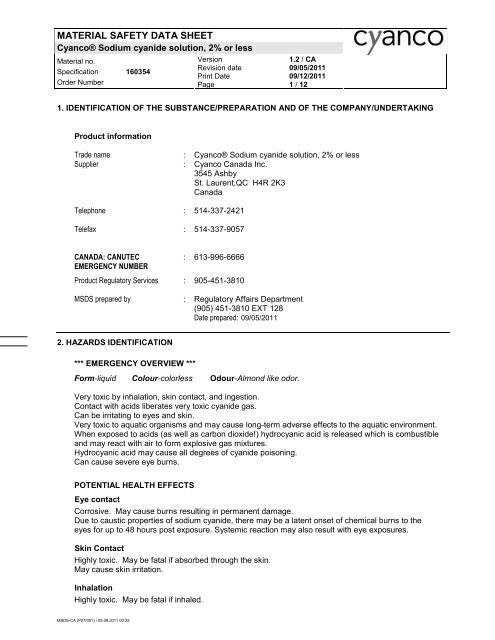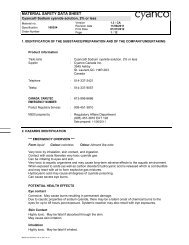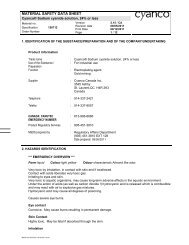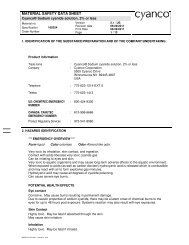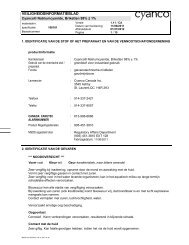Cyanco® Sodium cyanide solution, 2 or less - EN MSDS
Cyanco® Sodium cyanide solution, 2 or less - EN MSDS
Cyanco® Sodium cyanide solution, 2 or less - EN MSDS
Create successful ePaper yourself
Turn your PDF publications into a flip-book with our unique Google optimized e-Paper software.
MATERIAL SAFETY DATA SHEET<br />
<strong>Cyanco®</strong> <strong>Sodium</strong> <strong>cyanide</strong> <strong>solution</strong>, 2% <strong>or</strong> <strong>less</strong><br />
Material no.<br />
Specification 160354<br />
Order Number<br />
<strong>MSDS</strong>-CA (P27/001) / 05.09.2011 00:25<br />
Version 1.2 / CA<br />
Revision date 09/05/2011<br />
Print Date 09/12/2011<br />
Page 1 / 12<br />
1. ID<strong>EN</strong>TIFICATION OF THE SUBSTANCE/PREPARATION AND OF THE COMPANY/UNDERTAKING<br />
Product inf<strong>or</strong>mation<br />
Trade name : <strong>Cyanco®</strong> <strong>Sodium</strong> <strong>cyanide</strong> <strong>solution</strong>, 2% <strong>or</strong> <strong>less</strong><br />
Supplier : Cyanco Canada Inc.<br />
3545 Ashby<br />
St. Laurent,QC H4R 2K3<br />
Canada<br />
Telephone : 514-337-2421<br />
Telefax : 514-337-9057<br />
CANADA: CANUTEC<br />
EMERG<strong>EN</strong>CY NUMBER<br />
: 613-996-6666<br />
Product Regulat<strong>or</strong>y Services : 905-451-3810<br />
<strong>MSDS</strong> prepared by : Regulat<strong>or</strong>y Affairs Department<br />
(905) 451-3810 EXT 128<br />
Date prepared: 09/05/2011<br />
2. HAZARDS ID<strong>EN</strong>TIFICATION<br />
*** EMERG<strong>EN</strong>CY OVERVIEW ***<br />
F<strong>or</strong>m-liquid Colour-col<strong>or</strong><strong>less</strong> Odour-Almond like od<strong>or</strong>.<br />
Very toxic by inhalation, skin contact, and ingestion.<br />
Contact with acids liberates very toxic <strong>cyanide</strong> gas.<br />
Can be irritating to eyes and skin.<br />
Very toxic to aquatic <strong>or</strong>ganisms and may cause long-term adverse effects to the aquatic environment.<br />
When exposed to acids (as well as carbon dioxide!) hydrocyanic acid is released which is combustible<br />
and may react with air to f<strong>or</strong>m explosive gas mixtures.<br />
Hydrocyanic acid may cause all degrees of <strong>cyanide</strong> poisoning.<br />
Can cause severe eye burns.<br />
POT<strong>EN</strong>TIAL HEALTH EFFECTS<br />
Eye contact<br />
C<strong>or</strong>rosive. May cause burns resulting in permanent damage.<br />
Due to caustic properties of sodium <strong>cyanide</strong>, there may be a latent onset of chemical burns to the<br />
eyes f<strong>or</strong> up to 48 hours post exposure. Systemic reaction may also result with eye exposures.<br />
Skin Contact<br />
Highly toxic. May be fatal if abs<strong>or</strong>bed through the skin.<br />
May cause skin irritation.<br />
Inhalation<br />
Highly toxic. May be fatal if inhaled.
MATERIAL SAFETY DATA SHEET<br />
<strong>Cyanco®</strong> <strong>Sodium</strong> <strong>cyanide</strong> <strong>solution</strong>, 2% <strong>or</strong> <strong>less</strong><br />
Material no.<br />
Specification 160354<br />
Order Number<br />
May cause irritations of the respirat<strong>or</strong>y tract.<br />
Ingestion<br />
Highly toxic. May be fatal if swallowed.<br />
Potential environmental effect<br />
<strong>MSDS</strong>-CA (P27/001) / 05.09.2011 00:25<br />
Version 1.2 / CA<br />
Revision date 09/05/2011<br />
Print Date 09/12/2011<br />
Page 2 / 12<br />
Very toxic to aquatic <strong>or</strong>ganisms; may cause long-term adverse effects in the aquatic environment.<br />
3. COMPOSITION/INFORMATION ON INGREDI<strong>EN</strong>TS<br />
Chemical nature<br />
Solution in water.<br />
Inf<strong>or</strong>mation on ingredients / Hazardous components<br />
<strong>Sodium</strong> <strong>cyanide</strong><br />
CAS-No. 143-33-9 Percent (Wt./ Wt.)
MATERIAL SAFETY DATA SHEET<br />
<strong>Cyanco®</strong> <strong>Sodium</strong> <strong>cyanide</strong> <strong>solution</strong>, 2% <strong>or</strong> <strong>less</strong><br />
Material no.<br />
Specification 160354<br />
Order Number<br />
<strong>MSDS</strong>-CA (P27/001) / 05.09.2011 00:25<br />
Version 1.2 / CA<br />
Revision date 09/05/2011<br />
Print Date 09/12/2011<br />
Page 3 / 12<br />
Maintain an open airway<br />
In case of breathing difficulties immediately apply oxygen.<br />
Immediately contact the emergency doct<strong>or</strong> immediately (alarm rep<strong>or</strong>t: <strong>cyanide</strong> / hydrocyanic acid<br />
poisoning).<br />
Skin contact<br />
No cases of <strong>cyanide</strong> intoxication have been observed to date following contact with dry sodium <strong>or</strong><br />
potassium <strong>cyanide</strong> on dry skin free of injuries. However, if the dry sodium <strong>or</strong> potassium <strong>cyanide</strong> comes<br />
in contact with moisture <strong>or</strong> acids, then hydrogen <strong>cyanide</strong> may be released, causing <strong>cyanide</strong> intoxication.<br />
Wash off immediately using large amounts of water (and soap if available) while removing all<br />
contaminated clothes and shoes.<br />
Immediately contact <strong>or</strong> summon an emergency physician immediately in case of intoxication symptoms<br />
(key terms: intoxication with <strong>cyanide</strong> / prussic acid).<br />
Eye contact<br />
In case of contact with the eyes, immediately flush eyes with copious amounts of water f<strong>or</strong> a minimum of<br />
15 minutes while removing clothes. It is imp<strong>or</strong>tant to seek medical attention f<strong>or</strong> all eye exposures due to<br />
potential caustic burns of the eyes.<br />
Immediately contact <strong>or</strong> summon an emergency physician in case of intoxication symptoms (key terms:<br />
intoxication with <strong>cyanide</strong> / prussic acid).<br />
An ophthalmologist should also be consulted f<strong>or</strong> evaluation of caustic burns to the eyes. Eye burns may<br />
not be apparent f<strong>or</strong> up to 48 hours post exposure due to the caustic properties of sodium <strong>cyanide</strong>.<br />
Ingestion<br />
Th<strong>or</strong>oughly rinse mouth with water.<br />
Seek professional medical care immediately.<br />
Do not induce vomiting<br />
Call emergency doct<strong>or</strong> immediately (alarm rep<strong>or</strong>t: <strong>cyanide</strong> / hydro-cyanic acid poisoning ).<br />
Immediately transp<strong>or</strong>t to a medical facility.<br />
Notes to physician<br />
IMPORTANT: Specific antidote and treatment may vary by region. If you are not familiar with current<br />
treatment recommendations, you should contact the Poison Control Center f<strong>or</strong> your region <strong>or</strong> country f<strong>or</strong><br />
specific recommendations and guidelines.<br />
Possible signs of poisoning:<br />
Intoxication is classified by 2 categ<strong>or</strong>ies:<br />
Mild poisoning<br />
Severe poisoning<br />
The following symptoms are not sufficient to ensure a c<strong>or</strong>rect diagnosis:<br />
Symptoms of the central nervous system:<br />
Early stage: headache, dizziness, somnolence (drowsiness), nausea.<br />
Advanced stage: seizures, coma.<br />
Pulmonary symptoms:<br />
Early stage: dyspnea, tachypnea.<br />
Advanced stage: hyperventilation, Cheyne-Stokes respiration, apnea.<br />
Cardiovascular symptoms:<br />
Early stage<br />
hypertension, sinus arrhythmia, atrioventricular arrhythmia, bradycardia.<br />
Advanced stage: tachycardia, complex arrhythmia, cardiac arrest.<br />
Skin symptoms:<br />
Early stage: rosy skin col<strong>or</strong>.<br />
Advanced stage: cyanosis.<br />
Effect on the metabolism:<br />
Lactate acidosis: pH 7.1 and lactate level of 17 mmol/l are described.
MATERIAL SAFETY DATA SHEET<br />
<strong>Cyanco®</strong> <strong>Sodium</strong> <strong>cyanide</strong> <strong>solution</strong>, 2% <strong>or</strong> <strong>less</strong><br />
Material no.<br />
Specification 160354<br />
Order Number<br />
<strong>MSDS</strong>-CA (P27/001) / 05.09.2011 00:25<br />
Version 1.2 / CA<br />
Revision date 09/05/2011<br />
Print Date 09/12/2011<br />
Page 4 / 12<br />
Treatment:<br />
NOTE: The treatment advice may vary by region. See Material Safety Data Sheet <strong>or</strong> contact regional<br />
poison control center f<strong>or</strong> appropriate antidote treatment used in your region.<br />
The rescuer <strong>or</strong> medical responder should first of all protect themselves from exposure.<br />
Decontaminate the victim to prevent further abs<strong>or</strong>ption and exposure to rescuers. Monit<strong>or</strong> vital signs.<br />
Rapid treatment with appropriate antidote therapy is essential to saving lives during a high dose acute<br />
exposure to <strong>cyanide</strong>. NOTE: removal of toxic substance has equal imp<strong>or</strong>tance to implementation of<br />
antidote therapy.<br />
NOTE: This is an outline of antidotes available f<strong>or</strong> inf<strong>or</strong>mational purposes. It is imp<strong>or</strong>tant f<strong>or</strong> the treating<br />
physician to be familiar with the administration of <strong>cyanide</strong> antidotes available in the country where the<br />
chemical is being used!<br />
Mild poisoning<br />
Treatment is dependant on clinical presentation with symptoms and hist<strong>or</strong>y of exposure (related to<br />
dose).<br />
100% oxygen and artificial respiration if indicated.<br />
Closely monit<strong>or</strong> patient and their vital signs (Blood pressure, pulse and respirations).<br />
Monit<strong>or</strong> the patient f<strong>or</strong> onset of symptoms <strong>or</strong> deteri<strong>or</strong>ation of status.<br />
Depending on the pathology and clinical findings, based on strictly monit<strong>or</strong>ed controls of the clinical<br />
findings, it may be necessary f<strong>or</strong> the physician to implement symptom-<strong>or</strong>iented treatment f<strong>or</strong> pulmonary<br />
edema prophylaxis. X-rays of the lungs may be necessary f<strong>or</strong> pulmonary edema diagnosis.<br />
Specific antidote treatment can be indicated f<strong>or</strong> moderate to severe <strong>cyanide</strong> intoxication: (It is imp<strong>or</strong>tant<br />
to know that there are several different types of antidotes available f<strong>or</strong> treatment of <strong>cyanide</strong> intoxication<br />
in different countries) If the treating physician is not familiar with <strong>cyanide</strong> exposure and treatment, they<br />
should contact the medical division of their regional poison control centers f<strong>or</strong> immediate assistance with<br />
additional inf<strong>or</strong>mation as needed.<br />
F<strong>or</strong> all <strong>cyanide</strong> exposure:<br />
All <strong>cyanide</strong> exposed persons should undergo continued monit<strong>or</strong>ing f<strong>or</strong> several hours, even if patient<br />
feels well to ensure there are no residual <strong>or</strong> recurrent poisoning symptoms.<br />
Severe poisoning<br />
Artificial respiration with 100% oxygen.<br />
Immediate antidote administration with the legal antidote f<strong>or</strong> the country of the exposure.<br />
Listed below are the two most commonly used antidotes:<br />
1. Methemoglobin-f<strong>or</strong>ming agent<br />
Nitrite Therapy: (amyl nitrite, sodium nitrite and sodium thiosulfate) (commonly referred to as the Tayl<strong>or</strong>,<br />
Lilly <strong>or</strong> Pasadena Cyanide Antidote Kit).<br />
F<strong>or</strong> moderate to severe exposures (patient still conscious)<br />
Amyl Nitrite Aspirols: (1-3 aspirols administered as an inhalant, held 1 -2 inches under the nose f<strong>or</strong> 15-<br />
30 seconds, and then remove f<strong>or</strong> 15-30 seconds) (read medication inf<strong>or</strong>mation insert pri<strong>or</strong> to<br />
administering).<br />
<strong>Sodium</strong> nitrite 300 - 600 mg administered intravenously over a period of 5 to 15 minutes.<br />
<strong>Sodium</strong> Thiosulfate (12.5 g - 100-500 mg/kg weight) intravenously over a period of 15-20 minutes.<br />
If patient is conscious, then sodium Thiosulfate may be administered as an antidote by itself: (see<br />
antidote package inf<strong>or</strong>mation insert)<br />
<strong>Sodium</strong> Thiosulfate (12.5 g - 100-500 mg/kg weight) IV may be administered depending on the clinical<br />
presentation and symptoms.<br />
2. Complexing antidote agent: Hydroxycobalamin (commonly known as the Cyanokit)<br />
Treatment as follows:<br />
Administer hydroxocobalamin (Cyanokit®) 5 g i.v. (70 mg/kg b.w. in adults) by infusion over a period of<br />
20 - 30 minutes. Administration of this dose can be repeated as required depending on the severity of<br />
poisoning. Infusion time f<strong>or</strong> repeated dose: 30 minutes to 2 hours. The only permissible route of<br />
administration f<strong>or</strong> hydroxocobalamine is intravenously. (The physician should read the medication<br />
package inf<strong>or</strong>mation carefully to ensure proper reconstitution to liquid state and administration of<br />
antidote!).
MATERIAL SAFETY DATA SHEET<br />
<strong>Cyanco®</strong> <strong>Sodium</strong> <strong>cyanide</strong> <strong>solution</strong>, 2% <strong>or</strong> <strong>less</strong><br />
Material no.<br />
Specification 160354<br />
Order Number<br />
5. FIRE-FIGHTING MEASURES<br />
<strong>MSDS</strong>-CA (P27/001) / 05.09.2011 00:25<br />
Version 1.2 / CA<br />
Revision date 09/05/2011<br />
Print Date 09/12/2011<br />
Page 5 / 12<br />
Flash point Not combustible.<br />
Lower explosion limit not applicable<br />
Upper explosion limit not applicable<br />
Autoignition temperature not applicable<br />
Suitable extinguishing media<br />
quenching powder<br />
In case of fire in the surroundings:, alkali powder quenching agent<br />
Extinguishing media which must not be used f<strong>or</strong> safety reasons<br />
carbon dioxide (CO2)<br />
Specific hazards during fire fighting<br />
May be released in case of fire: Hydro-cyanic acid<br />
Special protective equipment f<strong>or</strong> fire-fighters<br />
As in any fire, wear self-contained positive-pressure breathing apparatus, (MSHA/NIOSH approved <strong>or</strong><br />
equivalent) and full protective gear.<br />
Further inf<strong>or</strong>mation<br />
Standard procedure f<strong>or</strong> chemical fires. Ensure there are sufficient retaining facilities f<strong>or</strong> water used to<br />
extinguish fire. Water used to extinguish fire should not enter drainage systems, soil <strong>or</strong> stretches of<br />
water. Contaminated fire-extinguishing water must be disposed of in acc<strong>or</strong>dance with the regulations<br />
issued by the appropriate local auth<strong>or</strong>ities. Fire residues should be disposed of in acc<strong>or</strong>dance with the<br />
regulations.<br />
6. ACCID<strong>EN</strong>TAL RELEASE MEASURES<br />
Personal precautions<br />
Wear personal protective equipment.<br />
Keep out unprotected persons.<br />
Keep unauth<strong>or</strong>ized persons away.<br />
Ensure sufficient ventilation. Avoid skin contact because of the danger of skin abs<strong>or</strong>ption.<br />
Make safe <strong>or</strong> remove all sources of ignition.<br />
Environmental precautions<br />
Do not allow entrance in soil, stretches of water, groundwater, drainage systems, surface water.<br />
Cyanide-containing sewage water and <strong>solution</strong>s must be decontaminated bef<strong>or</strong>e entering a public canal<br />
netw<strong>or</strong>k <strong>or</strong> stretch of water.<br />
Methods f<strong>or</strong> cleaning up<br />
Abs<strong>or</strong>b with liquid-binding material e.g. inert abs<strong>or</strong>bent
MATERIAL SAFETY DATA SHEET<br />
<strong>Cyanco®</strong> <strong>Sodium</strong> <strong>cyanide</strong> <strong>solution</strong>, 2% <strong>or</strong> <strong>less</strong><br />
Material no.<br />
Specification 160354<br />
Order Number<br />
Pick up mechanically. Collect in suitable containers.<br />
<strong>MSDS</strong>-CA (P27/001) / 05.09.2011 00:25<br />
Version 1.2 / CA<br />
Revision date 09/05/2011<br />
Print Date 09/12/2011<br />
Page 6 / 12<br />
Dispose of abs<strong>or</strong>bed material in acc<strong>or</strong>dance with the regulations.<br />
Waste to be packed like clean product and to be marked. Identification label on packages not to be<br />
removed until recycling.<br />
Additional advice<br />
On contact with acid, hydrogen <strong>cyanide</strong> is produced.<br />
7. HANDLING AND STORAGE<br />
Handling<br />
Safe handling advice<br />
Container may be opened only under exhaust ventilation hood.<br />
Seal container hermetically immediately after use.<br />
St<strong>or</strong>e under lock and key <strong>or</strong> in a way that only skilled persons have access to it.<br />
Advice on protection against fire and explosion<br />
The product is not combustible.<br />
see section 5.<br />
St<strong>or</strong>age<br />
Requirements f<strong>or</strong> st<strong>or</strong>age areas and containers<br />
Keep container tightly sealed and st<strong>or</strong>e in a dry, well-ventilated place.<br />
clean, dry, lockable.<br />
Ensure there are sufficient retaining facilities f<strong>or</strong> water used to extinguish fire.<br />
Unsuitable materials aluminium<br />
Advice on common st<strong>or</strong>age<br />
Do not st<strong>or</strong>e together with: acid and acidic salts.<br />
Keep away from food, drink and animal feedingstuffs.<br />
8. EXPOSURE CONTROLS / PERSONAL PROTECTION<br />
Component occupational exposure guidelines<br />
• Hydrogen <strong>cyanide</strong><br />
CAS-No. 74-90-8<br />
Control parameters<br />
4.7 ppm as CN Ceiling Limit Value:(CAD BC OEL)<br />
as CN Skin designation:(CAD BC OEL) Can be abs<strong>or</strong>bed through the skin.<br />
4.7 ppm as CN Ceiling Limit Value (CEV):(CAD ON<br />
OEL)<br />
as CN Skin designation:(CAD ON OEL) Can be abs<strong>or</strong>bed through the skin.<br />
10 ppm<br />
11 mg/m3 as CN<br />
Ceiling Limit Value:(OEL (QUE))<br />
as CN Skin designation:(OEL (QUE)) Can be abs<strong>or</strong>bed through the skin.<br />
as CN (OEL (QUE)) Recirculation prohibited
MATERIAL SAFETY DATA SHEET<br />
<strong>Cyanco®</strong> <strong>Sodium</strong> <strong>cyanide</strong> <strong>solution</strong>, 2% <strong>or</strong> <strong>less</strong><br />
Material no.<br />
Specification 160354<br />
Order Number<br />
<strong>MSDS</strong>-CA (P27/001) / 05.09.2011 00:25<br />
Version 1.2 / CA<br />
Revision date 09/05/2011<br />
Print Date 09/12/2011<br />
Page 7 / 12<br />
4.7 ppm<br />
5.2 mg/m3 as CN<br />
Ceiling Limit Value:(CAD AB OEL)<br />
as CN Skin designation:(CAD AB OEL) Can be abs<strong>or</strong>bed through the skin.<br />
as CN (CAD AB OEL) Included in the regulation but with<br />
no data values. See regulation f<strong>or</strong><br />
further details<br />
4.7 ppm as CN Ceiling Limit Value:(CAD SK OEL)<br />
as CN Skin designation:(CAD SK OEL) Can be abs<strong>or</strong>bed through the skin.<br />
4.7 ppm as CN Ceiling Limit Value:(CAD MB OEL)<br />
as CN Skin designation:(CAD MB OEL) Can be abs<strong>or</strong>bed through the skin.<br />
• <strong>Sodium</strong> <strong>cyanide</strong><br />
CAS-No. 143-33-9<br />
Control parameters<br />
10 mg/m3 Time Weighted Average<br />
(TWA):(OEL (QUE))<br />
10 mg/m3 Time Weighted Average<br />
(TWA):(CAD AB OEL)<br />
5 mg/m3 Time Weighted Average<br />
(TWA):(CAD AB OEL)<br />
10 mg/m3 Time Weighted Average<br />
(TWA):(CAD BC OEL)<br />
3 mg/m3 Time Weighted Average<br />
(TWA):(CAD BC OEL)<br />
Total dust.<br />
Total dust.<br />
Respirable dust.<br />
Total dust.<br />
Respirable dust.<br />
5 mg/m3 as CN Ceiling Limit Value (CEV):(CAD ON<br />
OEL)<br />
as CN Skin designation:(CAD ON OEL) Can be abs<strong>or</strong>bed through the skin.<br />
5 mg/m3 as CN Ceiling Limit Value:(CAD AB OEL)<br />
as CN Skin designation:(CAD AB OEL) Can be abs<strong>or</strong>bed through the skin.<br />
5 mg/m3 as CN Ceiling Limit Value:(CAD BC OEL)<br />
as CN Skin designation:(CAD BC OEL) Can be abs<strong>or</strong>bed through the skin.<br />
10 ppm<br />
11 mg/m3 as CN<br />
Ceiling Limit Value:(OEL (QUE))<br />
as CN Skin designation:(OEL (QUE)) Can be abs<strong>or</strong>bed through the skin.<br />
as CN (OEL (QUE)) Recirculation prohibited<br />
5 mg/m3 Ceiling Limit Value:(CAD SK OEL)<br />
Skin designation:(CAD SK OEL) Can be abs<strong>or</strong>bed through the skin.<br />
5 mg/m3 as CN Ceiling Limit Value:(CAD MB OEL)<br />
as CN Skin designation:(CAD MB OEL) Can be abs<strong>or</strong>bed through the skin.<br />
Other inf<strong>or</strong>mation<br />
Suitable measuring processes are:
MATERIAL SAFETY DATA SHEET<br />
<strong>Cyanco®</strong> <strong>Sodium</strong> <strong>cyanide</strong> <strong>solution</strong>, 2% <strong>or</strong> <strong>less</strong><br />
Material no.<br />
Specification 160354<br />
Order Number<br />
Hydro-cyanic acid<br />
OSHA method ID 120<br />
Engineering measures<br />
<strong>MSDS</strong>-CA (P27/001) / 05.09.2011 00:25<br />
Version 1.2 / CA<br />
Revision date 09/05/2011<br />
Print Date 09/12/2011<br />
Page 8 / 12<br />
Engineer out the risk of exposure.<br />
Ensure suitable suction/aeration at the w<strong>or</strong>k place and with operational machinery.<br />
Personal protective equipment<br />
Respirat<strong>or</strong>y protection<br />
A respirat<strong>or</strong>y protection program that meets OSHA 1910.134 and ANSI Z88.2 <strong>or</strong> applicable<br />
federal/provincial requirements must be followed whenever w<strong>or</strong>kplace conditions warrant respirat<strong>or</strong> use.<br />
NIOSH's "Respirat<strong>or</strong> Decision Logic" may be useful in determining the suitability of various types of<br />
respirat<strong>or</strong>s.<br />
Hand protection<br />
Glove material Natural rubber (NR)<br />
Material thickness 0.5 mm<br />
Break through time >= 480 min<br />
Method DIN <strong>EN</strong> 374<br />
Glove material Nitrile<br />
Material thickness 0.11 mm<br />
Break through time >= 480 min<br />
Method DIN <strong>EN</strong> 374<br />
Glove material Nitrile<br />
Material thickness 0.33 mm<br />
Break through time >= 480 min<br />
Method DIN <strong>EN</strong> 374<br />
Glove material Polychl<strong>or</strong>oprene with natural-latex liner.<br />
Material thickness 0.6 mm<br />
Break through time >= 480 min<br />
Method DIN <strong>EN</strong> 374<br />
Glove material PVC gloves<br />
The above mentioned hand protection is based on knowledge of the chemistry and anticipated uses of<br />
this product but it may not be appropriate f<strong>or</strong> all w<strong>or</strong>kplaces. A hazard assessment should be conducted<br />
pri<strong>or</strong> to use to ensure suitability of gloves f<strong>or</strong> specific w<strong>or</strong>k environments and processes pri<strong>or</strong> to use.<br />
Eye protection<br />
goggles<br />
face-shield<br />
Skin and body protection<br />
chemical protective suit<br />
During cleaning w<strong>or</strong>k: rubber <strong>or</strong> plastic boots.<br />
To identify additional Personal Protective Equipment (PPE) requirements, it is recommended that a<br />
hazard assessment in acc<strong>or</strong>dance with the OSHA PPE Standard (29CFR1910.132) be conducted bef<strong>or</strong>e<br />
using this product.<br />
A safety shower and eye wash fountain must be readily available.<br />
Hygiene measures<br />
Avoid contact with skin.
MATERIAL SAFETY DATA SHEET<br />
<strong>Cyanco®</strong> <strong>Sodium</strong> <strong>cyanide</strong> <strong>solution</strong>, 2% <strong>or</strong> <strong>less</strong><br />
Material no.<br />
Specification 160354<br />
Order Number<br />
<strong>MSDS</strong>-CA (P27/001) / 05.09.2011 00:25<br />
Version 1.2 / CA<br />
Revision date 09/05/2011<br />
Print Date 09/12/2011<br />
Page 9 / 12<br />
After contact with skin, wash immediately with plenty of water.<br />
No eating, drinking, smoking, <strong>or</strong> snuffing tobacco at w<strong>or</strong>k. Wash face and/<strong>or</strong> hands bef<strong>or</strong>e break and end<br />
of w<strong>or</strong>k.<br />
preventive skin protection<br />
Keep w<strong>or</strong>king clothes separately.<br />
Avoid contaminating clothes with product.<br />
Immediately change moistened and saturated w<strong>or</strong>k clothes.<br />
Immediately rinse contaminated <strong>or</strong> saturated clothing with water.<br />
Protective measures<br />
All precautionary measures indicated have to be observed.<br />
The w<strong>or</strong>k-place related airb<strong>or</strong>ne concentrations have to be kept below of the indicated exposure limits.<br />
If w<strong>or</strong>kplace exposure limits are exceeded and/<strong>or</strong> larger amounts are released (leakage, spilling, dust)<br />
the indicated respirat<strong>or</strong>y protection should be used.<br />
9. PHYSICAL AND CHEMICAL PROPERTIES<br />
Appearance<br />
F<strong>or</strong>m liquid<br />
Colour col<strong>or</strong><strong>less</strong><br />
Odour Almond like od<strong>or</strong>.<br />
Safety data<br />
Melting point/range ca. 0 °C<br />
Boiling point/range ca. 100 °C<br />
Flash point Not combustible.<br />
Flammability not applicable<br />
Autoignition temperature: not applicable<br />
Autoinflammability not applicable<br />
Lower explosion limit not applicable<br />
Upper explosion limit not applicable<br />
maximum absolute explosive<br />
pressure<br />
not applicable<br />
Vapour pressure 14.7 hPa (20 °C)<br />
Density ca. 1.0 g/cm3 (20 °C)<br />
Bulk density not applicable<br />
Partition coefficient (n-octanol/water) not investigated<br />
Viscosity, dynamic not applicable
MATERIAL SAFETY DATA SHEET<br />
<strong>Cyanco®</strong> <strong>Sodium</strong> <strong>cyanide</strong> <strong>solution</strong>, 2% <strong>or</strong> <strong>less</strong><br />
Material no.<br />
Specification 160354<br />
Order Number<br />
Viscosity, kinematic not applicable<br />
Further inf<strong>or</strong>mation<br />
Miscibility in water completely miscible<br />
10. STABILITY AND REACTIVITY<br />
<strong>MSDS</strong>-CA (P27/001) / 05.09.2011 00:25<br />
Version 1.2 / CA<br />
Revision date 09/05/2011<br />
Print Date 09/12/2011<br />
Page 10 / 12<br />
Materials to avoid Under the action of acids (as well as carbon dioxide !) hydrocyanic acid is<br />
released which is combustible and may react with air to explosive gas<br />
mixtures., Keep away from acidic salts.<br />
Hazardous decomposition products HCN: Hydrogen <strong>cyanide</strong> (hydrocyanic acid)<br />
11. TOXICOLOGICAL INFORMATION<br />
Product Acute <strong>or</strong>al toxicity LD50 Rat: 258 mg/kg<br />
(calculated)<br />
Product Acute dermal toxicity LD50 Rabbit: 416 mg/kg<br />
Product Human experience Very toxic by inhalation and if swallowed.<br />
12. ECOLOGICAL INFORMATION<br />
Ecotoxicity effects<br />
Inhaling of (at already approx. 200 ppm HCN in the air breathed) <strong>or</strong><br />
swallowing (approx. 200 - 300 mg KCN) can result in immediate<br />
unconsciousness and death.<br />
Can be abs<strong>or</strong>bed through the skin.<br />
Poisoning has an effect on the central nervous system.<br />
Irritating to eyes, respirat<strong>or</strong>y system and skin.<br />
Toxicity to fish LC50 Leuciscus idus melanotus: 0.07 mg/l<br />
Test substance: solid product<br />
Method: literature<br />
related to substance: <strong>Sodium</strong> <strong>cyanide</strong><br />
Toxicity to daphnia EC50 Daphnia magna: 0.3 mg/l<br />
Test substance: solid product<br />
Method: literature<br />
related to substance: <strong>Sodium</strong> <strong>cyanide</strong>
MATERIAL SAFETY DATA SHEET<br />
<strong>Cyanco®</strong> <strong>Sodium</strong> <strong>cyanide</strong> <strong>solution</strong>, 2% <strong>or</strong> <strong>less</strong><br />
Material no.<br />
Specification 160354<br />
Order Number<br />
<strong>MSDS</strong>-CA (P27/001) / 05.09.2011 00:25<br />
Version 1.2 / CA<br />
Revision date 09/05/2011<br />
Print Date 09/12/2011<br />
Page 11 / 12<br />
Toxicity to bacteria EC50 Escherichia coli: 0.004 mg/l<br />
Test substance: solid product<br />
Method: literature<br />
related to substance: <strong>Sodium</strong> <strong>cyanide</strong><br />
13. DISPOSAL CONSIDERATIONS<br />
WASTE DISPOSAL<br />
Advice on disposal Waste must be disposed of in acc<strong>or</strong>dance with local, state, provincial and<br />
federal laws and regulations. Empty containers must be handled with care<br />
due to product residue.<br />
14. TRANSPORT INFORMATION<br />
T.D.G. Road/Rail<br />
Class 6.1<br />
UN-No 3414<br />
Packing group I<br />
Proper shipping name SODIUM CYANIDE SOLUTION<br />
Marine pollutant Marine pollutant<br />
Sea transp<strong>or</strong>t IMDG-Code<br />
Class 6.1<br />
UN-No 3414<br />
Packaging group I<br />
Marine pollutant Marine pollutant<br />
EmS F-A, S-A<br />
Proper technical name (Proper shipping name)<br />
SODIUM CYANIDE SOLUTION<br />
Marine pollutant Marine pollutant<br />
Air transp<strong>or</strong>t ICAO-TI/IATA-DGR<br />
Class 6.1<br />
UN-No 3414<br />
Packaging group I<br />
Proper technical name (Proper shipping name)<br />
<strong>Sodium</strong> <strong>cyanide</strong> <strong>solution</strong><br />
Transp<strong>or</strong>t/further inf<strong>or</strong>mation<br />
Do not st<strong>or</strong>e together with acids (danger of toxic gases) <strong>or</strong> with foodstuffs, consumables and<br />
feedstuffs.
MATERIAL SAFETY DATA SHEET<br />
<strong>Cyanco®</strong> <strong>Sodium</strong> <strong>cyanide</strong> <strong>solution</strong>, 2% <strong>or</strong> <strong>less</strong><br />
Material no.<br />
Specification 160354<br />
Order Number<br />
15. REGULATORY INFORMATION<br />
Canadian Regulations<br />
<strong>MSDS</strong>-CA (P27/001) / 05.09.2011 00:25<br />
Version 1.2 / CA<br />
Revision date 09/05/2011<br />
Print Date 09/12/2011<br />
Page 12 / 12<br />
This <strong>MSDS</strong> has been prepared in compliance with the Controlled Product Regulations except f<strong>or</strong> use<br />
of the 16 headings.<br />
WHMIS Classification<br />
• D1A<br />
• D2B<br />
International Chemical Invent<strong>or</strong>y Status<br />
Un<strong>less</strong> otherwise noted, this product is in compliance with the invent<strong>or</strong>y listing of the countries shown<br />
below. F<strong>or</strong> inf<strong>or</strong>mation on listing f<strong>or</strong> countries not shown, please contact Regulat<strong>or</strong>y Affairs<br />
Department.<br />
• Europe (EINECS/ELINCS) Listed/registered<br />
• USA (TSCA) Listed/registered<br />
• Canada (DSL) Listed/registered<br />
• Australia (AICS) Listed/registered<br />
• Japan (MITI) Listed/registered<br />
• K<strong>or</strong>ea (TCCL) Listed/registered<br />
• Philippines (PICCS) Listed/registered<br />
• China Listed/registered<br />
• New Zealand Listed/registered<br />
16. OTHER INFORMATION<br />
HMIS Ratings<br />
Further inf<strong>or</strong>mation<br />
Health : 3<br />
Flammability : 0<br />
Physical Hazard : 1<br />
Changes since the last version are highlighted in the margin. This version replaces all previous versions.<br />
The inf<strong>or</strong>mation provided in this Safety Data Sheet is c<strong>or</strong>rect to the best of our knowledge, inf<strong>or</strong>mation<br />
and belief at the date of its publication. The inf<strong>or</strong>mation given is designed only as a guidance f<strong>or</strong> safe<br />
handling, use, processing, st<strong>or</strong>age, transp<strong>or</strong>tation, disposal and release and is not to be considered a<br />
warranty <strong>or</strong> quality specification. The inf<strong>or</strong>mation relates only to the specific material designated and<br />
may not be valid f<strong>or</strong> such material used in combination with any other materials <strong>or</strong> in any process, un<strong>less</strong><br />
specified in the text.


